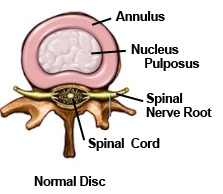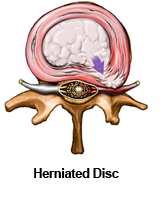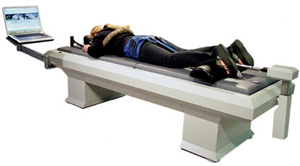What is VAX-D?
VAX-D Description
VAX-D Stands for Vertebral Axial Decompression. It was invented by Dr. Alan Deyer, MD. It’s a FDA cleared revolutionary non-surgical treatment, for a number of neck and low back disc-related conditions.
It is so successful, that it is used by many physicians across the country, in orthopedic medicine, Pain pain management and Neurosurgery. VAX-D treats neck and low back conditions, which produce buttock, arm, hip, hand, groin, thigh, and leg and foot pain.
These Conditions Range From:
VAX-D is an effective and safe procedure without any of the risks associated with surgery, injections, or anesthesia. Time off from work or in recovery is minimal, and resolution of symptoms can be long-lasting. VAX-D has been seen on ABC, CBS and NBC news.
VAX-D is a very effective treatment for a number of conditions. In order for you to understand how VAX-D works, you need to understand the anatomy that makes up the structures of your back.

The spine is made up of twenty four movable bones called vertebrae. These vertebrae run down the center of your back. Between each movable vertebra is a disc. The disc act as a cushion or a shock absorber, that provides flexibility and movement to the spine. Additionally, they also act as a ligament to hold the vertebrae together.
Unfortunately over time, these discs can become injured and worn out, which is why people face so much trouble with their back.

The anatomy of the disc is quite simple. The outside of the disc is made up of a fibrous shell called the annulus. The inside of the disc is made up of a jelly-like substance called the nucleus pulposes. The strong annular fibers hold in the soft jelly like nucleus pulposus. An example of this to think about is a jelly doughnut.
Unfortunately, as you get older a disc loses their blood supply. Therefore, when you have an injury to a disc, it is difficult for that disc to heal on its own. When discs are healthy and uninjured, they retain their shape. When they are degenerated and injured, they push out and put pressure on the surrounding spinal nerve roots.

Discs undergo a tremendous amount of stress, which can sometimes lead to a bulging disc. A bulging disc is a weakening of the disc wall, which causes the disc to bulge out and press painfully on the surrounding nerves. It’s like a hamburger that's too big for its bun.
A herniated disc, on the other hand, occurs when the pressure within the disc becomes too great. This causes a crack or fissure to develop in the tougher outer layer of cartilage (the annulus), which allows some of the softer material inside, to protrude out of the disc. It’s like squeezing a jelly-doughnut. This in turn, may then impinge painfully on the nerves, causing severe muscle spasms and severe pain. It can also lead to numbness, tingling, or muscle weakness in the arms and legs. A herniated disc is also called a ruptured disc or a slipped disc.

Typically, spinal stenosis and degenerated disc disease are seen in older people. Stenosis and degeneration of the spine and discs, is a gradual result of aging and “wear and tear” on the spine. Stenosis means a narrowing of the spinal canal, due to the encroachment of disc material or bony growths that squeeze and irritate the spinal cord, or nerve roots.
On the other hand, degenerated disc disease happens when a disc degenerates or breaks down. This may be from years of strain, overuse, and maybe even misuse. Both these conditions can lead to pain, numbness, tingling, or weakness in both the arms and legs.
Why Choose VAX-D
VAX-D is effective, painless and safe. For patients suffering from the conditions listed above, VAX-D is the answer. Prior to VAX-D, the only documented way to correct disc problems, was through surgery. VAX-D takes the escaped disc material and retracts it back into place by decompression.
VAX-D achieves decompression through a timed series of pulls, holds and releases, lasting over a period of 30 minutes. The decompression cycle produces a negative pressure within the disc. This is what allows the treatment to be so successful.
This negative pressure creates a vacuum effect, which draws nutrients and vital fluids into the disc, to promote the repair of the injured disc, and the surrounding tissue. This is crucial to the healing process, because without it, the disc won’t heal. This is what makes VAX-D such a clinical breakthrough.
Some patients have reported immediate relief just after one treatment, although it usually takes longer. Some conditions require fewer treatments, while some require more. Each treatment is customized to a patient’s individual injury.
VAX-D is able to get the intradiscal pressure down to negative levels, which is so crucial in the success at treating disc injuries.

VAX-D has also been shown to treat degenerative disc disease and stenosis. It has a rejuvenating effect on the degenerative disc. In addition it also reduces the pain associated with stenosis by pulling the disc back into place.
How A VAX-D Treatment Works

The patient is fitted with pelvic or neck harness depending on which area is being treated. The patient then lies face-down (or face-up) on the table. The upper body is then positioned on the stationary portion of the table. The patient is restrained by the use of passive arm-rest restraints.
The system applies tension in a smooth (patented) logarithmic time/force curve that allows the muscles to relax. When the muscles relax decompression is achieved, with a negative pressure being achieved in the disc. Each decompression cycle lasts for 60 seconds. So each patient will receive a total of 15 decompression cycles, over the span of 30 minutes.
Patients find the treatment to be comfortable and relaxing. Many experience a relief of their pain and symptoms during the treatment.
Four Phases of Spinal Decompression
There are four phases of decompression therapy:
Phase 1
During this phase, 200 mg negative pressure is achieved in the disc. This in turn brings the nucleus material back into the center of the disc. Pressure is released off the nerve dramatically reducing the pain. The disc is reduced in size.
Phase 2
The disc jelly material continues to be drawn toward the center of the disc. The injured disc circular fibers will start the healing process. This happens as proteoglycans and oxygen flow back into to the disc through the negative intradiscal pressure that was created.
Phase 3
The fibrous tissue is about to heal.
Phase 4
Complete healing of the circular fibers of the disc, and containment of the disc. Patients can now return to a normal healthy, active lifestyle, free from pain.

Do visit our clinic if you are suffering from neck and low back disc-related conditions.
News & Updates
Limited time offer!
We are offering a free consultation with the doctor. We also accept most insurance plans in and out of network, plus auto and workers comp.